Mayotte |
|
|
|
| Übersicht – Contents: | |
Diese Seite ist Teil des Projektes
Mayotte |
|
|
|
| Übersicht – Contents: | |
Flaggen – Flag: |
|
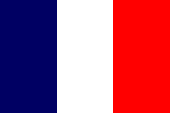 |
die Flagge
Frankreichs |
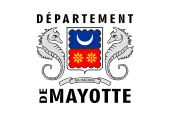 |
seit /since 2013, |
|
|
|
historische Flagge – historical Flag: |
|
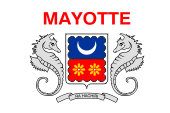 |
2004–2013, |
|
|
|
inoffizielle Flagge – unofficial Flag: |
|
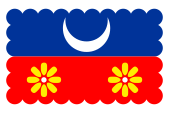 |
inoffizielle Wappenflagge (?) |
|
|
|
| Alle französischen Kolonien, hatten über lange Zeit keine eigene Flagge. Es musste die französische Trikolore gehisst werden. Das gilt im Prinzip bis heute. Der Status der Kolonien änderte sich über die Jahre. Einige sind heute Überseedepartements, und damit ein ultraperipherischer Teil Frankreichs und auch der EU; andere sind Überseegemeinschaften, die autonom sind, und nicht Teil Frankreichs oder der EU. Überseedepartements gehören – nicht wie die Departements des Mutterlandes – zu keiner administrativen Region Frankreichs, sondern bilden eine eigene Region. |
All French colonies had no own flag over a long period. It had to be hoisted the French tricolor. This in principle usual until today.
The status of the colonies changed over the years. Some of them are now overseas departments, and thus a ultraperipheric part of France and of the EU; others are overseas communities, autonomous, and not a part of France or the EU. Overseas departments belong – in contrast to the departments of the motherland – to no administrative region of France, they are a separate region. |
| Die Gebietskörperschaft muss demzufolge offiziell die Flagge Frankreichs verwenden, jedoch können der Generalrat als oberstes gewähltes Kollegialorgan eines französischen Départements und auch der Regionalrat als oberstes gewähltes Kollegialorgan einer französischen Region eigene Flaggen haben. | The territorial entity has therefore officially to use the flag of France. However, the General Council as the highest elected collegial body of a French Department and the Regional Council as the highest elected collegial body of a French Region can have their own flags. |
| Diese Départements- und Regionsflaggen haben allerdings oft das Erscheinungsbild von Firmenflaggen mit Logos oder gar stilisierten Bildern, wirken lieblos, unhistorisch, technokratisch und modernistisch, denn im streng zentralistischen Frankreich wird jedwede Regionalität oder gar ein Bezug zur Geschichte vermieden. Darum sind diese Regions-Logo-Flaggen unbeliebt und werden kaum benutzt. | These flags of departments and regions, however, have oftenly the appearance of company flags with logos or even stylized images, appear carelessly, ahistorical, technocratic and modernist, because in the strictly centralist France is avoided any regionalism or even a historical subscription. Because of that these logo flags of regions are unpopular and are rarely used. |
| Der Generalrat des Departements hatte (als Verwaltungsorgan) seit 1982 seine eigene Flagge. Diese Flagge wurde 2011 von einer neuen Flagge ersetzt, die das Departement als Gebietskörperschaft repräsentiert. Die Flagge des Generalrats zeigte das Wappen von Mayotte mit dem Landesnamen in roter Schrift darüber auf einem weißen Tuch. Die Flagge des Départements ist ähnlich, jedoch ist in Inschrift schwarz und zeigt die Worte "DÉPARTEMENT" oberhalb des Wappens und darunter "DE MAYOTTE". |
The General Council of the Department (as an administrative body) had its
own flag since 1982. That flag was displaced in
2011 by a new flag representing the department as a territorial
collectivity. The flag of the General Council showed the coat of arms of Mayotte with the country's name in red above it on a white bunting. The flag of the department is similar, but the inscription is black and shows the words "DÉPARTEMENT" above the coat of arms, and below "DE MAYOTTE". |
| Für lokale und touristische Zwecke gibt es wahrscheinlich – wie bei fast allen französischen Besitzungen üblich – noch die bekannten und beliebten Wappen-Flaggen. Dazu wird das Bild des Wappenschilds des Landes auf ein Flaggentuch übertragen. Jedoch ist das für Mayotte nicht sicher. Im Internet lassen sich solche Abbildungen finden, auch Abwandlungen davon, jedoch ist die tatsächliche Verwendung fraglich. |
But, there exist probably, for local and tourist purposes – like usual in almost all French possessions - the famous and popular crest flags, where the image of the Coat of Arms of the country is transferred to a bunting.
However, that is not certain in the case of Mayotte. Such images can be found on the Internet, including modifications, but the actual use is questionable. |
| Quelle/Source: Wikipedia (RF), World Statesmen, Volker Preuß | |
|
|
|
| Wappen – Coat of arms: | |
 |
Wappenschild von Mayotte – escutcheon of Mayotte, Quelle/Source: nach/by: Wikipedia (EN), Flag of Mayotte, Public domain, via Wikimedia Commons |
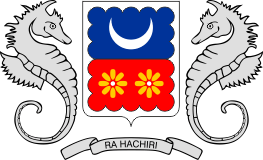 |
Wappen von Mayotte – Coat of arms of Mayotte, Quelle/Source: nach/by: Wikipedia (EN), Flag of Mayotte, Public domain, via Wikimedia Commons |
|
|
|
| Das Wappen von Mayotte wurde 1982 eingeführt. Es ist ein in silbernem Bogenschnitt bordiertes Wappen und von Blau und Rot geteilter Schild. Oben ein silberner, liegender Mond und unten zwei goldene sechsblättrige Blüten mit silbernem Butzen. Schildhalter sind zwei silberne Seepferdchen. Unter dem Wappen die Devise auf silbernem Band mit schwarzen Majuskeln „RA HACHIRI“ („Wir sind wachsam“). |
The
coat of arms of Mayotte was introduced in 1982. It is a silvery invected-bordered crest and divided
from blue and red divided shield. Above, a silvery, lying moon and below two golden six-petalled flowers. Supporters are two silvery seahorses.
Under the coat of arms the motto on a silvery ribbon with black capital letters "RA HACHIRI" ("We are vigilant"). |
| Quelle/Source: Wikipedia (EN) | |
|
|
|
| Landkarten – Maps: |
Die Lage der Komoren – position of the Comoros: |
Komoren – Comoros: |
|
|
|
| Zahlen und Fakten – Numbers and Facts: | |
|
|
|
|
|
|
|
|
|
|
|
|
|
|
|
|
|
|
| Quelle/Source: Wikipedia (D) | |
|
1416 · arabische Eroberung von Mayotte ca. 1500 · portugiesische Eroberung von Mayotte 1506 · Mayotte gehört zum Sultanat Komoren 25.08.1841 · Mayotte wird französische Kolonie 1886 · Frankreich erklärt die anderen Komoreninseln zum Protektorat 1912 · Schaffung der französischen Kolonie Komoren 1946 · die Komoren werden französisches Überseeterritorium 1974 · Volksabstimmung auf Mayotte über die Unabhängigkeit der Komoren, die Mehrheit der Mahorais lehnt die Unabhängigkeit ab 1975 · die Komoren erklären sich für unabhängig und erheben Ansprüche auf Mayotte 1976 · Volksabstimmung auf Mayotte über die Unabhängigkeit, die Mehrheit der Mahorais lehnt erneut die Unabhängigkeit ab 1985 · eine Flüchtlingswelle strömt von den Komoren auf die Insel 1991 · eine Flüchtlingswelle strömt von den Komoren auf die Insel 2009 · Volksabstimmung, Mayotte soll Übersee-Département und Übersee-Region werden 2011 · Mayotte wird Übersee-Département und Übersee-Region, wobei Generalrat und Regionalrat zusammengelegt werden, das Land wird eine "Collectivité territoriale unique" |
|
|
|
1416 · Arabian conquest of Mayotte ca. 1500 · Portugese conquest of Mayotte 1506 · Mayotte belongs to the Sultanate of Comoros 25.08.1841 · Mayotte is a French colony 1886 · France declares the other Comoros Islands to a protectorate 1912 · establishing of the French Colony of the Comoros 1946 · the Comoros become a French overseas territory 1974 · referendum on Mayotte about the independence of the Comoros, the majority of the Mahorais rejects the independence 1975 · the Comoros declare themself for independent and power claims on Mayotte 1976 · referendum on Mayotte about the independence, the majority of the Mahorais rejects the independence again 1985 · a refugee torrent comes from the Comoros on the island 1991 · a refugee torrent comes from the Comoros on the island 2009 · referendum, Mayotte has to become an overseas department and an overseas region 2011 · Mayotte becomes an overseas department and an overseas region, whereby the General Council and Regional Council are merged, the country becomes a "Collectivité territoriale unique" |
| Quelle/Source: Wikipedia (D), Volker Preuß |
|
|
| Das Wort "Mayotte" ist ein französischer Name für die einheimische Bezeichnung "Maoré". Dieser Name für die Insel entstand um 1500, weil sich hier ein eigenständiger Staat, der "Maoré" or "Mawuti" genannt wurde, herausgebildet hatte. Die Bezeichnungen kommen aus der arabischen Sprache und sollen "Insel der Toten" bzw. "Insel des Todes" bedeuten. Die Einwohner selber nennen sich "Mahorais". |
The word "Mayotte" is
the French name for the local name "Maoré". This name for this island came
into beeing ca. in 1500, because an independent state, who was called "Maoré" or "Mawuti",
had emerged here. The names come from the Arabic language and are intended to mean "Island of the Dead" or "Island of Death". The inhabitants call themselves "Mahorais". |
| Quelle/Source: Wikipedia (D) | |
|
|
|